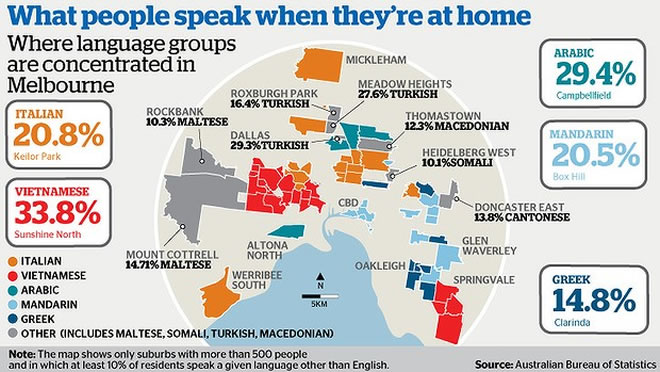

Saturday, July 12, 2014
It is a thoroughly modern metropolis, a changing city where as older European voices begin to trail off, Mandarin's volume grows louder, particularly in the inner city.
It's a city that can be justifiably proud of its linguistic diversity and one whose forefathers might scarcely recognise from the discussions around them. But demographers warn Melbourne's melting-pot status could be at risk as rising house prices force new migrants into concentrated pockets.
Across the city, three in 10 people speak a language other than English when they get home and the variety grows daily as migration reshapes a city and its people. A major analysis carried out by Fairfax Media reveals 200,000 more Melburnians are speaking a language other than English at home than a decade ago.
In 6 per cent of suburbs more than half the population speaks languages other than English at the dinner table.
And in seven such suburbs, English is not the dominant language. Vietnamese is the most common language in four of these - Cairnlea, Braybrook, Sunshine North and Springvale.
In Campbellfield, in Melbourne's north, 1494 people speak Arabic compared with 985 English speakers, census data shows. About 80 per cent of the community here speak a language other than English at home - the highest proportion of any suburb in the state.
In nearby Dallas and Meadow Heights, Turkish is the dominant language but Assyrian and related dialects thrive and almost a sixth of the population of both places speak Arabic.
Ghada Ibrahim runs a weekly Arabic playgroup at Meadow Heights Primary School and says many of the parents in the group are recent migrants who cannot speak English very well, but often their children communicate fluently in both English and Arabic.
Ms Ibrahim wants her two sons to speak Arabic so they can communicate with her family in Lebanon, but she encourages families from the playgroup to learn English as well. "I say, speak Arabic and English together," she says. "English is also very important."
Arabic is the sixth-most commonly spoken language other than English in metropolitan Melbourne, behind Greek, Italian, Mandarin, Vietnamese and Cantonese.
But that is changing. Between 2001 and 2011, the number of Mandarin speakers jumped from about 60,000 to 100,000, driven by new arrivals. Mandarin is now the second-most spoken language in inner city areas including the CBD and Carlton, while in affluent Glen Waverley, 13 per cent of people speak it at home.
Across the state there are small pockets where less widespread languages are commonly spoken in the community. Information technology specialist Abdisalam Mohamed lives in Heidelberg West, in Melbourne's north east, where one in 10 people speaks Somali at home.
"Speaking the Somali language will keep our culture and heritage alive," he says.
"Within our community, all the transaction is done in Somali language and I expect our children to speak Somali and pass on this language to their kids as well."
Only 44 of Victoria's 1546 suburbs are home to a Somali speaker. Italian is the most widely dispersed non-English language, followed by German and Dutch.
Since moving to Australia from the US in February, Monash University city science lecturer Meead Saberi has also been analysing Melbourne's population. His team have created maps that visualise ethnic distribution and he says he was pleasantly surprised to see what the data showed.
"Most American cities - such as Chicago and Washington DC - are very segregated," he says. "Half the city is white, half the city is black and they are not mixing at all. But Melbourne is very mixed."
But Monash University population researcher Bob Birrell warns economic currents could be pushing language groups towards greater segregation.
"The big picture is quite clear," he says. "As Melbourne's population expands very rapidly and competition for housing increases … those with limited resources, particularly recently arrived migrants who are from the family reunion and refugee stream, will have no choice but to move into relatively low-cost middle and outer suburbs."
He says a widening rich-poor divide and booming house prices could prevent newer migrants from dispersing through the city like earlier generations of Europeans.
But in many cases languages are also concentrated in particular areas for cultural reasons, according to Giang Nguyen. Mrs Nguyen, 44, left Vietnam for Australia three decades ago and now lives in Braybrook in Melbourne's west. She says Vietnamese migrants often settled in the area for family rather than financial reasons. "The Vietnamese are a close-knit community and family based," she says.
When she arrived in Australia as a refugee, she couldn't speak a word of English. She grew up in Maribyrnong and all but abandoned her mother tongue after learning English. "There were certain parts of my life where I didn't speak Vietnamese at all," she says. "I thought it was much better to be Australian. Now I look back and think that is stupid - you can be both."
Mrs Nguyen started speaking Vietnamese in the home again after having children because she wanted her kids to be able to speak both English and Vietnamese. "It does keep the connection with the motherland and our roots," she says. "I think my children will be able to appreciate the multiculturalism in Australia because they are a part of it."